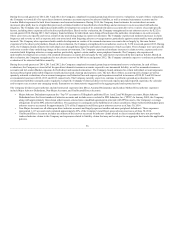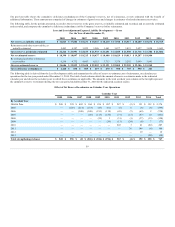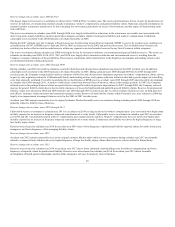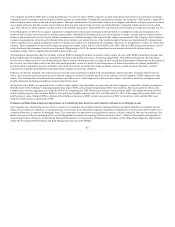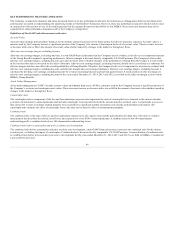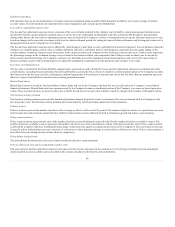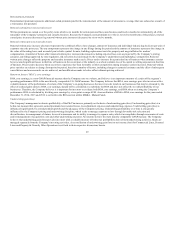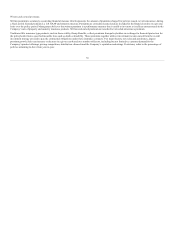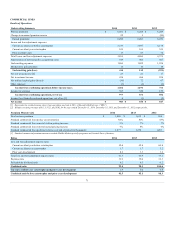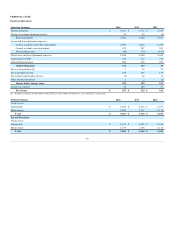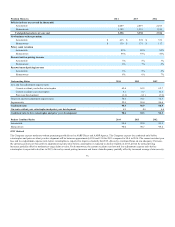The Hartford 2014 Annual Report Download - page 66
Download and view the complete annual report
Please find page 66 of the 2014 The Hartford annual report below. You can navigate through the pages in the report by either clicking on the pages listed below, or by using the keyword search tool below to find specific information within the annual report.
The Company considers the measures and ratios discussed below to be key performance indicators for its businesses. Management believes that these ratios
and measures are useful in understanding the underlying trends in The Hartford’s businesses. However, these key performance indicators should only be used
in conjunction with, and not in lieu of, the results presented in the segment discussions that follow in this MD&A. These ratios and measures may not be
comparable to other performance measures used by the Company’s competitors.
Definitions of Non-GAAP and other measures and ratios
Account Value
Account value includes policyholders’ balances for investment contracts and reserves for future policy benefits for insurance contracts. Account value is a
measure used by the Company because a significant portion of the Company’s fee income is based upon the level of account value. These revenues increase
or decrease with a rise or fall in the amount of account value whether caused by changes in the market or through net flows.
After-tax core earnings margin, excluding buyouts
After-tax core earnings margin, excluding buyouts, is a non-GAAP financial measure that the Company uses to evaluate, and believes is an important measure
of, the Group Benefits segment’s operating performance. After-tax margin is the most directly comparable U.S. GAAP measure. The Company believes that
after-tax core earnings margin, excluding buyouts, provides investors with a valuable measure of the performance of Group Benefits because it reveals trends
in the business that may be obscured by the effect of buyouts. After-tax core earnings margin, excluding buyouts, should not be considered as a substitute for
after-tax margin and does not reflect the overall profitability of Group Benefits. Therefore, the Company believes it is important for investors to evaluate both
after-tax core earnings margin, excluding buyouts, and after-tax margin when reviewing performance. After-tax core earnings margin, excluding buyouts is
calculated by dividing core earnings excluding buyouts by revenues excluding buyouts and realized gains (losses). A reconciliation of after-tax margin to
after-tax core earnings margin, excluding buyouts for the years ended December 31, 2014, 2013 and 2012 is set forth in the After-tax margin section within
MD&A - Group Benefits.
Assets Under Management
Assets under management (“AUM”) include account values and mutual fund assets. AUM is a measure used by the Company because a significant portion of
the Company’s revenues are based upon asset values. These revenues increase or decrease with a rise or fall in the amount of account value whether caused by
changes in the market or through net flows.
Catastrophe ratio
The catastrophe ratio (a component of the loss and loss adjustment expense ratio) represents the ratio of catastrophe losses incurred in the current calendar
year (net of reinsurance) to earned premiums and includes catastrophe losses incurred for both the current and prior accident years. A catastrophe is an event
that causes $25 or more in industry insured property losses and affects a significant number of property and casualty policyholders and insurers. The
catastrophe ratio includes the effect of catastrophe losses, but does not include the effect of reinstatement premiums.
Combined ratio
The combined ratio is the sum of the loss and loss adjustment expense ratio, the expense ratio and the policyholder dividend ratio. This ratio is a relative
measurement that describes the related cost of losses and expenses for every $100 of earned premiums. A combined ratio below 100 demonstrates
underwriting profit; a combined ratio above 100 demonstrates underwriting losses.
Combined ratio before catastrophes and prior accident year development
The combined ratio before catastrophes and prior accident year development, a non-GAAP financial measure, represents the combined ratio for the current
accident year, excluding the impact of catastrophes. Combined ratio is the most directly comparable U.S. GAAP measure. A reconciliation of combined ratio
to combined ratio before prior accident year reserve development for the years ended December 31, 2014, 2013 and 2012 is set forth in MD&A - Commercial
Lines and Personal Lines.
66


